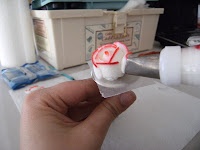Never heard of candy melts? They’re little chocolate discs that you melt down and pour into molds. You can do it a couple of ways, the traditional double boiler method, or the way I did it, using the microwave. There’s a rainbow of colors, and you can use as many or as few as you want depending on your molds. The best part about them is they are already tempered, which you would have to do yourself if you wanted to make candy out of regular chocolate. You know they’ll set up every time and there’s no worry about having a gooey chocolate mess on your hands from failed chocolate.
- Chocolate mold(s) of your choice—see note below
- Candy melts in desired colors to fill your mold
- If you plan on multiple colors per mold you will need disposable decorating bags.
- Storage solution for finished candy. I use plastic wrap and colored ribbon.
- If your mold is designed for it, a package of lollipop sticks, cookies, or pretzel rods.
The molds I chose were Easter themed lollipops, but the same process applies to any mold you choose. Also, it’s helpful to get 2 of the same mold, so while one is in the fridge hardening you can still be working with the other. A second is not necessary, but it definitely makes the project go faster.
- Clear a space in the refrigerator wide enough to accommodate your molds (and any lollipop sticks if necessary).
- Melt your candy melts. If you want one solid color, you can melt them down in a glass container with a pour spout. (Pyrex you are my friend for this project and many others.) If you’ll be mixing colors in the same mold, melt each color in a disposable decorating bag. There’s directions on the candy melts package depending on your preferred melting method.
- Pour candy into mold, decorating as you see fit. Make sure to fill it all the way to the top.
- If your mold is designed for lollipops add the sticks. Rotate them to cover the end in chocolate, which will secure it into the lollipop upon hardening.
- Tap the mold on the counter or table top. This lets any air bubbles rise to the surface and fills in any spots in the mold you may have missed. This is especially important if you’re using decorating bags to fill your molds. Look at the photos of my finished chocolates. I obviously forgot this step, which is why I’m making a big deal out of it now. Whatever. They still taste the same…
- Place the molds in the refrigerator until the candy has hardened. It usually takes 15 to 20 minutes.
- Take the candies out of the fridge, pop them out of the molds, and (optionally) chow down! If you go to unmold the chocolates and you’re having a tough time getting them out, it means they aren’t ready. Pop them back in the fridge and check them again in 10 minutes.
- Wrap any candies you won’t be eating right away, or store it in an air-tight container. I usually wrap mine individually. Use an appropriately sized piece of plastic wrap, fold it in half around the chocolate portion, gather the ends together at the base of the candy and tie them around the lollipop stick using colored ribbon. (They look really pretty in gift baskets this way.) If you’re too lazy for that, Wilton also makes little candy wrapping kits especially for this purpose.
In total, I spent $5 for this project (2 molds on sale, and one color of candy melts). I had some of the lollipop sticks and a couple colors of chocolate left over from Christmas. So if you add the sticks, roughly $8. (It was a mega pack.) I won’t count the colors since I had so many, but the candy melts are approximately $3 each when regularly priced. That’s a lot more chocolate than you get in the Easter candy bags at the grocery store, and I can re-use the molds next year. Definitely pleased…














